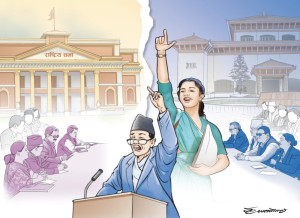Columns
Better prepared next time
Five lessons we can learn from the Gorkha Earthquake to build safer communities.
Jitendra Bothara
The earthquake of 2015 was a tragic event that caused mass causalities and damage and destruction in Nepal. The post-earthquake response from all over the world helped Nepal get through a very tough time in its history. Almost six years on, here are five lessons we can learn from the Gorkha Earthquake to continue building safer and more resilient communities.
Firstly, pre-2015 efforts to improve earthquake safety were mostly restricted to urban areas and of a limited scale. Traditional buildings and rural areas have not improved enough in earthquake safety despite their known vulnerability. As a result, traditional buildings were affected disproportionally, causing thousands of casualties in the Gorkha Earthquake. The large majority of the new buildings reconstructed in the earthquake-affected areas could be considered earthquake-resilient because they have been constructed following the building code, but this is not the norm in the rest of the country. Unfortunately, there are a significant number of buildings that are unsafe. Complete replacement of these vulnerable buildings or retrofitting them to meet the building code in its entirety on a mass scale is economically and technically unviable. Thus, we need a pragmatic approach to improve the safety of these buildings.
An adaptable approach
New Zealand’s approach may be relevant here, where all existing buildings (other than small houses) must meet at least 34 percent of the requirements of their building code, or these must be retrofitted in a given time frame. This way, the buildings can survive medium intensity earthquakes and be economically viable. An approach like New Zealand’s that is pragmatic in Nepal’s context will help to improve the safety of the existing buildings and protect our communities. As well as this, a policy framework would be necessary to highlight the roles of different levels of governments and incentivise private and public stakeholders to retrofit their buildings.
Secondly, despite the vulnerability of our infrastructure, it suffered relatively less damage during the Gorkha Earthquake because the intensity of the tremor was mild where most of the infrastructure existed. Nepal is investing heavily in infrastructure, which is a perfect opportunity to construct them safer and resilient, and improve the existing ones. Unsafe infrastructure will result in catastrophic damage and financial losses in future earthquakes and greatly disrupt Nepal’s growth and prosperity. Roads in and out of the Kathmandu Valley need to be earthquake safer and resilient. Due to financial and technological limitations, in certain instances, we may not be able to have resilient infrastructures, and in these cases, it will be essential to have alternative backup plans to mitigate disruptions and reduce losses.
Thirdly, Nepal is well recognised for its architecture, culture and traditions-the presence of seven UNESCO World Heritage Sites in the Kathmandu Valley is a testament to this. This gives Nepal a special status and identity on a global scale promoting tourism to our country. Their survival is essential to maintain our cultural identity, and they need to be passed on to the next generation. Despite only mild shaking, the Gorkha Earthquake damaged and destroyed many temples, palaces, rest houses and other cultural structures and sites in the Kathmandu Valley.
A comprehensive framework needs to be developed for their documentation, seismic assessment and sympathetic strengthening, and restoration. All of these will require research. In certain instances, it may not be possible to strengthen the heritage structures, but comprehensive documentation will help to restore them if they are damaged or destroyed in future earthquakes. This will avoid conflict and delay in restoration as we saw after the Gorkha earthquake.
Fourthly, we need to improve our research environment and facilities to address earthquake safety issues that are unique to Nepal. For years, we have adopted and adapted from other countries resulting in less-than-optimal earthquake safety measures while not addressing the uniquity of Nepal’s context. Sustained efforts to improve safety requires an understanding of the multi-dimensional interplay between technology, socio-economics, culture, and politics. As citizens of this country, we have an in-depth understanding of these complexities, and need to take leadership in addressing these issues.
For example, more than 60 percent of the buildings in Nepal are constructed using stone and brick in mud mortar, which is highly vulnerable to earthquakes. These buildings are constructed from locally sourced materials that are readily available, usable and affordable. These building types are sustainable, but most of them are not resilient to earthquakes. We need to conduct research and innovate practical, affordable and replicable methods to improve the resiliency of these traditional buildings. This requires building innovative research facilities and tools within our financial and logistical limitations.
A similar example is seen at the Institute of Technology, Roorkee, India where they constructed a shock table in the 1970s using scrapped railway bogies. The recommendations made by the Indian Building Code on earthquake-resilient construction of stone and mud buildings are based on experimental testing completed on this shock table, which continues to be used to this day. Such facilities are under development in Nepal currently and the need is to link these with engineering education.
Coordination and collaboration
Lastly, the most important lesson of the earthquake is to recognise the importance of coordination and collaboration between government, national and international organisations, the private sector, and all other relevant stakeholders. Nepal has moved from a fatalistic approach to safety to a proactive and informed approach. As a result, we have taken a long stride in implementing and amending policy measures to improve disaster risk management. The National Disaster Risk Reduction and Management Authority has been established to provide leadership and coordination to maintain our momentum in disaster risk reduction. This is a difficult task because earthquakes are infrequent, yet our efforts to mitigate them must be continuous to realise the benefits during future earthquakes. Moving forward, the authorities in Nepal should develop coordinated and pragmatic short-, medium-, and long-term plans and visualise where we should be in the years to come.
We must understand that there is no absolute safety because it is dependent on factors such as technology, resources, and risk perception. Improving safety is an incremental process and will take time. Achieving safety levels of the developed and technology-driven countries in Nepal on a mass scale is not feasible due to vast differences between the countries. What we need to do is prioritise and take small but confident and coordinated steps. Our focus should be on improving earthquake safety for all our communities, given Nepal’s unique limitations and strengths.




 6.64°C Kathmandu
6.64°C Kathmandu















